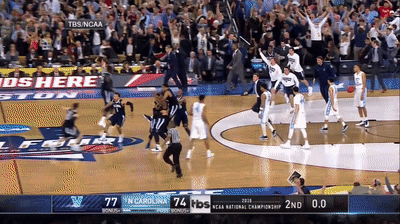WTF is March Madness?

gif via imgr
Ah spring time. The flowers are blooming, the weather is transitioning from parkas to light bombers, and it’s time for some playoff basketball. No, not the NBA, that’s in April & May. It’s March Madness. Time for the college kids to get some shine.
The tournament as old as your grandmother is now as big of a marketing monster as the $10 billion broadcasting contract indicates. However, the tournament isn’t as simple as it looks. You have conference tournaments, selection committees, and play-in games determining how this early spring tournament is built. There’s a lot of information to get down. With that, here are some of the answers to what the fuck is March Madness?
What is it?
Essentially, March Madness is a colloquialism for the NCAA Men’s & Women’s Division I Basketball tournament. The men’s competition runs from March 14 to April 3, while the women’s goes from March 17 to April 2. It also includes the conference tournaments which are played in March, in order to build the field for the main tournament itself.
So, it’s called “March Madness” because it’s in March?
Basically. The men’s tournament has been around since 1939, taking place on the last 2 weeks of March. The term itself is from a 1908 Illinois basketball tournament, but was popularized in the 1980s by Brett Musburger. Now, it’s the casual term for the NCAA and CBS/Turner Broadcasting’s $10 billion basketball industry. The women’s tournament was added to the NCAA docket in 1982.
How many teams are in it?
Technically 68 for the men, 64 for the women. The teams are ranked 1–16 in 4 different regions, split in the bracket. The teams are also ranked 1–64/68 — with a unanimous selected top overall seed. This year, it is Villanova for the men and University of Connecticut (UConn) for the women.
Why is it “Technically 68”?
There are “First Four” play-in games in the Men’s tournament. 8 teams play for the right to be a lower-seeded team in the tournament, starting the tournament a little early. It started in 2001, with 2 teams playing for the chance to be the 16th seed (aka get immediately knocked out in the next round).
So they play that game in order to get to the main tournament in order to get knocked out?
It is technically a part of the tournament, but they’re playing to move on to a second round, which is where the other 60 teams get involved. Also, not all play-in teams are done after the first week. Virginia Commonwealth University was a play-in team in 2011, becoming an 11th seed. They finished their tournament run in Houston, Texas, bowing out in the Final Four. Upsets are a major part of the game
Ok, cool cool. ESPN uses the word “Bracketology” a lot when they talk about this. WHAT THE FUCK IS BRACKETOLOGY?
They’re playing that shit out. Bracketology is an ESPN term at this point, concerned with how the tournament field of at-large teams are selected and not selected for the tournament. It’s been traced back to ESPN’s Joe Lunardi in 1995. The Philadelphia native would edit together the Blue Ribbon College Basketball Yearbook, a 400 page preseason college basketball stats and review magazine. One year, he threw in a bracket and worked on predicting the tournament field. He’s been known for this ever since.
Oh, also, what’s RPI?
RPI is the ratings percentage index, a formula used by the selection committee to rank teams against each other over the course of the regular season and to choose teams for the tournament. It’s been used for the tournament since 1981, but is factored into most college sports governed by the NCAA. The basic formula is 25% team winning percentage + 50% opponents’ average winning percentage + 25% opponents’ opponents’ average winning percentage.
So, how do you get in?
The easiest way is to have a good record, be a major team, and have a strong, balanced schedule. You know when big name teams play smaller schools at the beginning of the year, like Duke vs Marist or Univ. of Arizona vs Texas Southern? They’re playing to put down a solid base of wins to start the year. From there, before conference play, they play games against teams more on their caliber to have a strong win or even a strong loss. Games like Kentucky vs Kansas and Indiana vs University of North Carolina-Chapel Hill (UNC) are done to impress the selection committee, a national committee of 10 university athletic directors from around the country. Additionally, winning the post-regular season conference tournament is a guaranteed entry.
An example?
Ok, let’s take the Ivy League. The league recently instituted a post-season tournament after holding out for years, to preserve amateur sports. Princeton won the tournament, and have been guaranteed a spot in the tournament. 32 teams get in this way every year.
On the other side is Kansas, who got knocked out of the Big 12 conference tournament by Texas Christian University (TCU), but were nationally ranked as the #1 seed at that time, now with a record of 28–4. They’re definitely getting in. The national selection chooses the other 36 teams, using the RPI, national ranking, and other factors (like injuries of players and coaches) as a way to debate the merits of one team versus another going into the tournament.
Alright, so let’s get to the good stuff. There’s a shit ton of gambling right?
A shit ton is an understatement. There’s the office pools, which cause billions to be lost in productivity (and are technically illegal). There’s the many online bracket competitions and the different winnings from those. And there’s Warren Buffet’s Berkshire Hathaway Sweet 16 challenge for his employees. There’s a big business in this realm alone.
Ummmmm who gone win?
In the Men’s tournament,last year’s champ Villanova, fellow 2016 finalist UNC, Kansas, and Duke are all favorites this year. For the Women’s tournament, it’s 2013–16 champion UConn, South Carolina, Washington, and Baylor.

Who’s an underdog to root for?
There’s so many. In terms of favorites, Gonzaga is a #1 seed, but also considered an outsider’s chance. Northwestern is among several teams going to the tournament for the first time. Also, they’ve got Seinfeld love.
Nah, fuck that. Where the upsets at?
That’s an unpredictable science, but I’ll say 3 things:
- Always put a 13 over a 4 or a 12 over a 5 somewhere in your bracket. ALWAYS. This tournament is super unpredictable. Ask Georgetown.
- However, don’t go upset crazy. Make sure that there’s a couple of #1 seeds in your elite eight and going forward. Out of the last 6 final fours, four have had #1 seeds as winners and all have featured at least one #1 seed.
- Apparently, there’s a 1 in 2 billion chance at a perfect bracket, so don’t sweat it. Joe in your office’s pool will probably get half the sweet 16 correct. Any more than that is always an autowin. Trust. I’ve won pools while getting the overall winners wrong, but about 14/16 of the sweet 16 right. That’s how it works sometimes.
Now excuse me, I got to go figure out the odds on Duke winning for one of my 18 brackets. I want a new TV.



